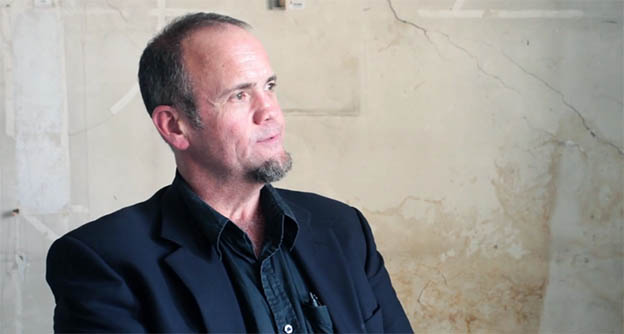[Video] Shadows in Dust: John Ford turns abandoned apartment into art

John Ford talks about his recent work 'Second Sight: Shadows in Dust' in a new online video.
Art can often be found hanging on the wall, but can the wall itself be considered art?
John Ford thinks so. In fact, his recent project “Second Sight: Shadows in Dust”, profiled in the video below, doesn’t just include walls – it features an entire abandoned apartment.
Ford, an assistant professor in the School of the Arts, typically works with “found objects”, or whatever items are available for him to use. In this case, however, it’s the items that aren’t present, as well as the dust and imprints left from those which are long gone, that tell that story of the former home.
Ford talk about the project, funded by McMaster’s Arts Research Board, below.
The location of this project is important to understand. Where exactly is it?
It was situated in a room in a recently-vacated apartment in Kraków, Poland. It is one of many buildings in the city which has disputed ownership, the result of forcible removals during the Second World War and subsequent take-overs by communist governments. The city now rents out the spaces until ownership can be legally established.
In this particular building was businesses, residential spaces and the Art Academy of Kraków’s Department of Intermedia. The department had recently taken occupancy of a unique space above their existing space, a combination apartment/studio that had been occupied by an elderly couple, the husband being a painter, who had recently passed away. Regrettably, the widow had to be relocated, and I came into this space that had been lived in for many decades. I was faced with the question: “How do I occupy/inhabit this place, filled with so many experiences and the memories of this couple?”.
How would you describe the intentions of this project?
In the most simple way, it was an attempt to interact with the residue left by recent occupants of a living space, then react by intervening in this space anew, such that my gentle contributions become part of the historic character of the space. I was carefully adding a kind of “insight” to this “site”.
Was this project research or art?
That’s a good question, and I think for the university setting, it needs to be said that art and research are one and the same. This is especially true if the artist is in the habit of asking “What am I supposed to do next?” or “How can I play a role in a new context, such that I am able to help the normal inhabitants of the city see in new ways?” This sort of engagement, without predetermined objectives, is in fact the art of research. The subject of the research is seeking new questions rather than answers, testing and pushing the limits of what I’ve known or experienced, or what static bodies of knowledge or information tell us is the truth, or what we should know.
Describe what this project means to you, independently and in relation to your other works?
It is very meaningful to have time and space to engage in a physical, intellectual, maybe even psycho-emotive exercise, without a predetermined outcome in mind. As I said in the video, there is an element of play, but by play I do not mean something frivolous or completely self-indulgent. There is a real discipline, investment, and tenacity to what I call serious play, and it is the sort of exercise and application of ones talents, ones insights, ones imagination. It is in this state of serious play that some of the best work, research, and creation has happened in the human world, whether in art, in science, in engineering, in medicine, in business. Serious play is often found to be at the heart of the best, the highest level of achievement of humanity, and that’s what this project meant to me. I honestly think that without serious play, there would be no innovation, and the imagination would atrophy.
As it relates to my other work? My life’s work is completely inter-related, so this project was one more project in the unfolding of my life, in some ways like the project I am working on now, the renovation of an old building to be my home and studio. So, if I examine this Kraków project in terms of how it relates to the rest of my work, it is probably best that I get a little distance, then I’ll be most able to draw the references.
‘Second Sight: Shadows in Dust’ John Ford from studioFILMLOVE on Vimeo.

